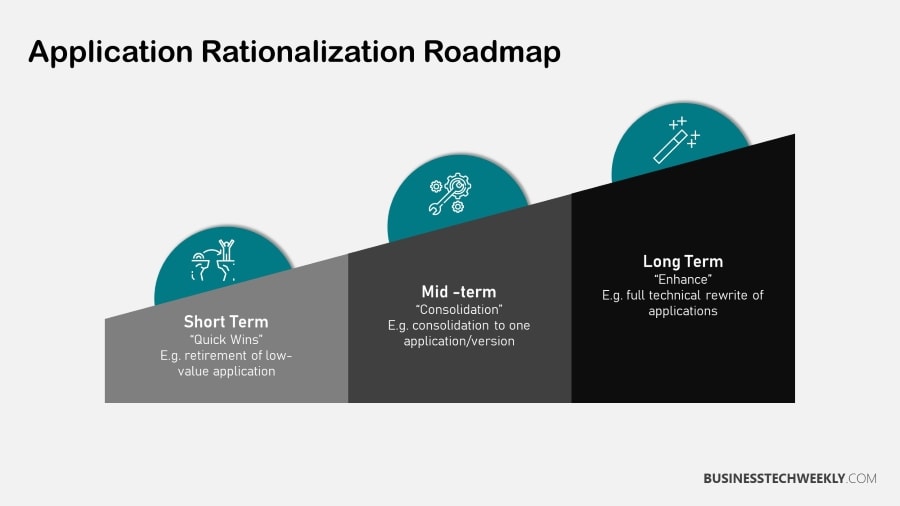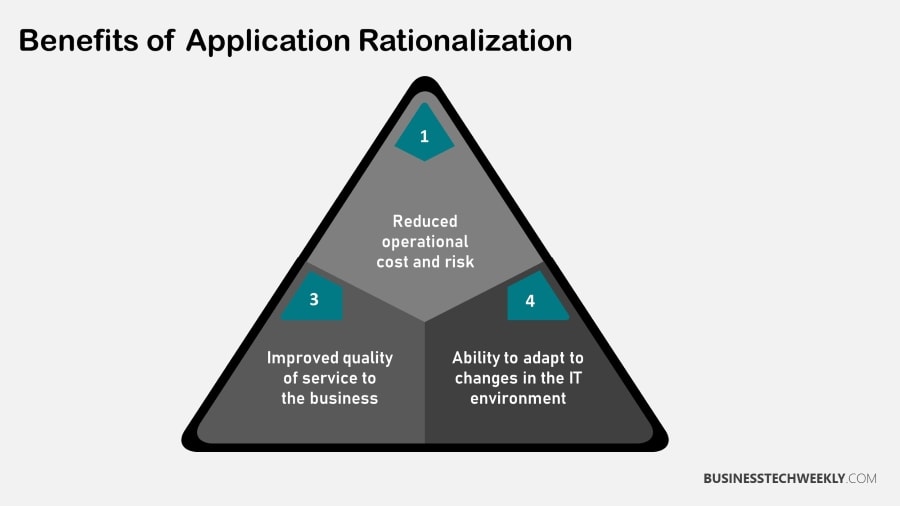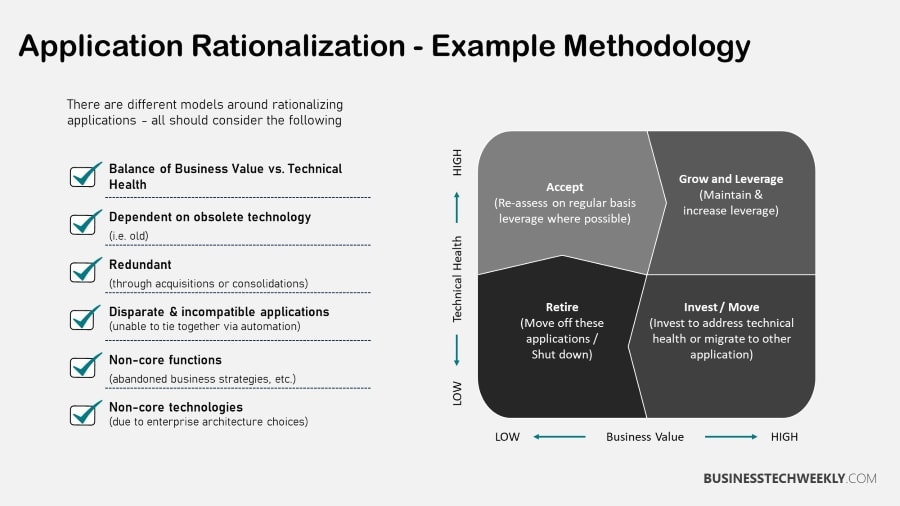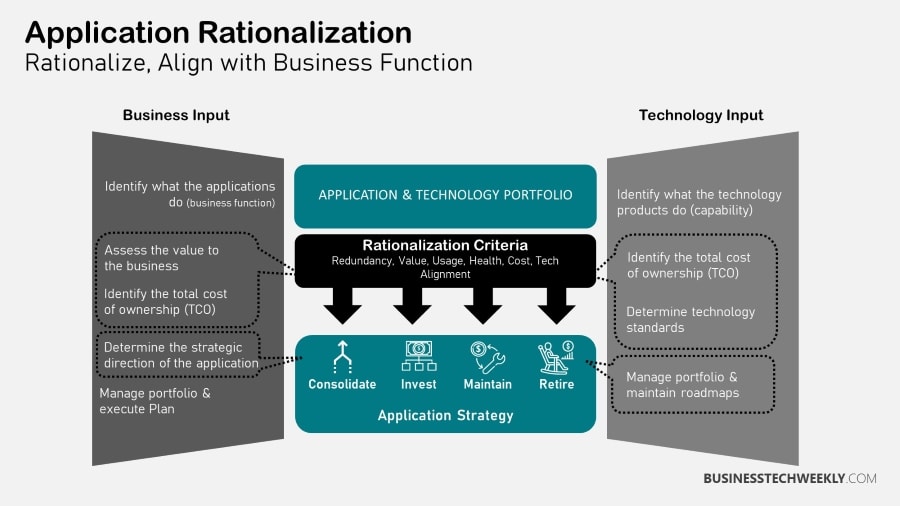Getting Started with Application Rationalization

Making informed business decisions across the organizational landscape drives entrepreneurial success. An agile IT application portfolio allows businesses to respond to technology and trends rapidly. However, low-value legacy applications take up 70% to 80% of the IT budget, leaving scarce money to invest in business efficiencies.
Application rationalization presents an architectural vision which drives business goals, addresses concerns of the stakeholders and responds to strategic business drivers.
Application rationalization efforts establish transparency between stakeholders, optimize application portfolio, significantly cut down IT costs and uncover money invested in trending business initiatives.
On this page:
What Is Application Rationalization?
With application rationalization, an organization cuts down the size of its application portfolio. In simpler words, they look at using fewer applications than before.
Application rationalization brings down costs, reduces complexities, and improves overall efficiency. Costs are typically discussed in terms of Total Cost of Ownership (TCO), the overall calculated cost, and IT equipment.
RELATED: Economics of Cloud Computing: Driving Cost Efficiencies to Fuel Growth
Application rationalization is an initiative led by the CIO of the organization. The scale at which it is performed varies since industry leaders take a more calculative approach to application portfolio management, reducing the need for a significant overhaul.

Importance of Application Rationalization
Organizations use far more applications and software than they need, allowing plenty of space to save costs and remove unwanted applications. This can be a significant saving given that the cost of applications accounts for 80% of the IT expenditure.
Around 70% of organizations do not have a reference document for their existing application portfolio. Organizations could pay a hefty cost due to the negative results from this lack of documentation. Without a managed application portfolio, organizations may be,
- Unable to make necessary updates to bug fixes
- Stick to low-value projects
- Unable to quickly respond to changing business needs
- Unable to modernize the IT landscape
- Paying increased costs
- Unable to plan and optimize the IT environment effectively
Application rationalization can be an easy way to determine how much capital is available for reinvestment. It also facilitates communication between IT leaders and the decision-makers in the business.
Benefits of Application Rationalization
Research has shown that eliminating inefficiencies in the IT environment can lead to hundreds of dollars in savings, and application rationalization does just that. It reduces complexities in the IT landscape and brings down the overall IT expenditure.
- Eliminates Redundancy – A successful application rationalization project can easily uncover applications that perform similar tasks. Combining look-alike applications and removing the redundant ones lowers IT spending.
- Reduces Complexities – An outrageous number of applications running in your enterprise can create an overly complex IT environment. This makes innovation difficult and inconceivable.
- Reduces IT Support Costs – Every additional application used at the enterprise requires technical support from the in-house IT team. There has to be money spent on this support.
Fewer applications mean less money spent on maintenance. Application rationalization simplifies the application portfolio and improves overall IT efficiencies. It prevents the organization from overspending licence costs and investing in redundant programs.
- Saves IT Costs – It is common for application rationalization programs to uncover huge savings. The saved costs can be reinvested in next-gen initiatives such as machine learning, IoT and artificial intelligence.

Biggest Challenges to Application Rationalization
Disengagement From Stakeholders
Rationalization initiatives cannot be driven by the IT department alone. Since they need major changes in business processes, lack of collaboration from business partners can crush successful application rationalization initiatives.
The first step for stakeholder engagement is to have a transparent, fact-based conversation with them regarding the total cost of ownership of current applications. However, having a consensus on this number is easier said than done.
Simplistic assumptions will most likely be dismissed and complicated ones may not be as accurate. Finding an ideal balance between the two is what drives engagement.
Infrastructure managers and business stakeholders most probably know the issues in key areas of their portfolio already. These issues lie in older applications which run on legacy systems and hog dev resources, thus hindering innovation. It’s best to start investigating from there.
One does not need to peform an exhaustive TCO initiative. At the very least, it should address issues that are already flagged as a concern.
Bloated Application Portfolios
If you are looking at performing an application rationalization, chances are your application portfolio is already disoriented and complex.
Identifying applications in need of rationalization can be very difficult within a cumbersome portfolio. This is because bloated portfolios do a great job at hiding redundancy and locking innovation expenditure only towards legacy apps.
In this case, if you are struggling to keep a track of every in-use or paid application within the enterprise, making decisions based on redundancy and costs will be extremely difficult. It is much easier to assess the business value of each application within a smaller portfolio.
Even if the organization is confident that every application is recorded, extracting that information would be troublesome.
In some cases, data may also be buried within word documents and excel sheets and may be difficult to exchange. This can lead to collaboration difficulties within team members and teams.
Visualization of Data
In case you manage to access data of your entire application portfolio, the next challenge would be to make sense of the data.
When an enterprise has over 900 applications, it isn’t a cakewalk to identify the targets for rationalization. An excel sheet may do the trick for smaller organizations but they would still need tools and techniques for effective visualization.
An important aspect of application rationalization is presenting data to the stakeholders and gaining their buy-in, which becomes difficult without user-friendly presentation.
Steps To Build A Successful Application Rationalization Framework

Define Success Metrics
Metrics are needed to communicate success. Common focus areas for application rationalization efforts are:
- Figuring out which applications perform similar functions to each other within the same portfolio
- Reducing the count of application “vendors” that a business has to deal with
- Visualizing applications that are loosely aligned to strategic goals
- Scoring applications based on how they fit in business and technical perspective
- Reviewing application lifecycle and finding applications with early retirement scope or minimal usage
If a larger scope of rationalization is needed, organizations can use a combination of the approaches given above.
Centralize Data
Collect all the necessary data in a single repository using up to date application catalog and accurate lists of application ownership.
Build On The Gathered Data
Once the entire application portfolio is loaded in a central repository, the data has to be augmented with manually collected information. Ownership of the application and its lifecycle is of critical importance along with the usage of each application.
In order to establish a comprehensive picture of the impact applications have, you can link applications in the repository to business capabilities and processes.
Analyze Data
As mentioned earlier, you will have score applications to figure out which ones are in need of rationalization.
The three parameters that are typically used to score applications are Total Cost of Ownership, Business Fit and Technical Fit.
Business fit is a qualitative measure which identifies how much an application supports existing business processes and functionalities. An application is selected if an organization can leverage it to support or redefine an existing process.
Technical fit measures the technological health of an application and needs to be assessed in line with IT goals.
Assess Portfolio
After analyzing and scoring your applications, next you need to group your application portfolio. A common grouping could be based on criterias such as Invest, Tolerate, Migrate or Eliminate.
Applications grouped in “invest” have a high business and technical fit. As you can predict, organizations need to focus on investing in these applications and optimizing them.
Applications grouped in “tolerate” have a low business fit but they are high on technical fit. Such applications shouldn’t be paid much attention. However, there is a need to regularly monitor them in case their value decreases in the future.
Applications in the “migrate” group have a low technical fit but high business fit. These applications are real assets in terms of business value but they will have to be modernized in order for them to remain valuable.
Lastly, applications in the “eliminate” sorting are low on both technical and business fit and needs to be deliscenced.
Visualize Results
Using predefined visualizations and reports, the results from your analysis can be illustrated with ease. If you have used the analysis methodology above, then using a matrix to visualize applications will be clear and impactful.
Showcase The Application Roadmap
To mark a successful completion, you will have to present the conclusion to stakeholders. The results should reflect potential savings and other positive changes such as removal of redundant applications and also selection of applications in need of rationalization.

Conclusion
The need to achieve a technical edge is greater than ever. Hence, it is unsurprising to note that the number of applications a firm uses has dramatically risen.
Such application growth runs the risk of imposing significant costs on the company, not just from a finance perspective but from an efficiency point of view too. Each and every application should provide business value. No wonder application rationalization has grown in popularity.
Application rationalization isn’t an overnight initiative. It is however, the most beneficial tool in the enterprise architecture toolkit resulting in outsized gains in different areas.

